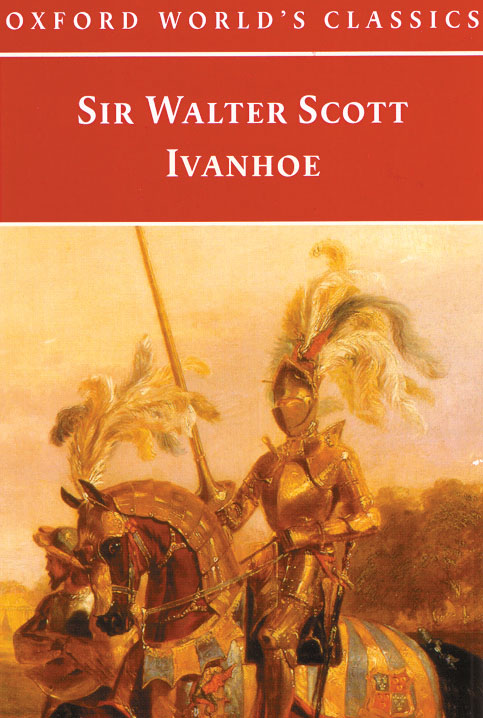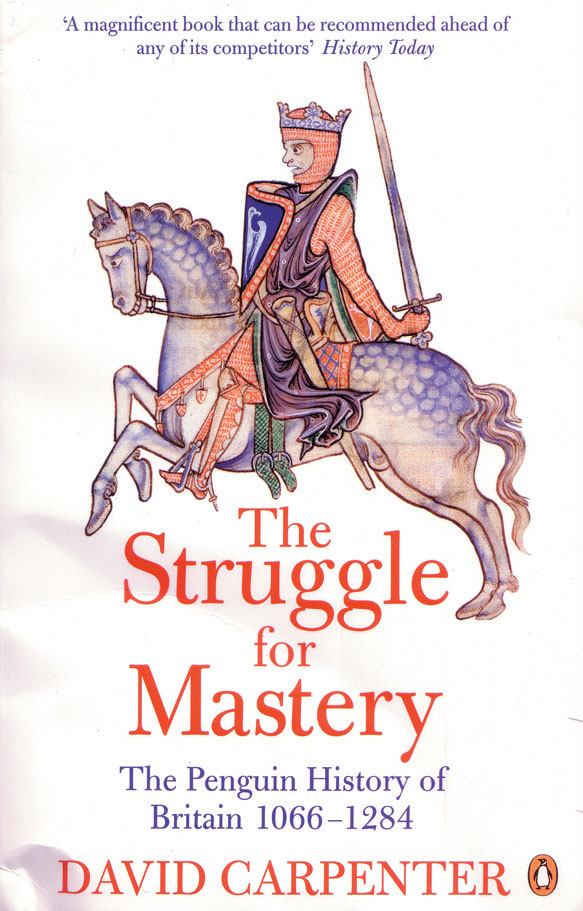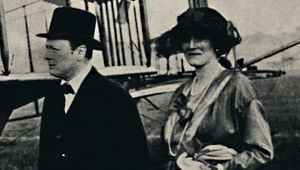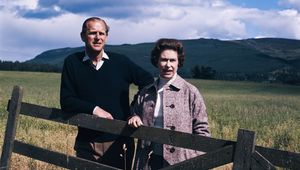
The Latest Books About Britain
SIR WALTER SCOTT’SIvanhoe sets the theme for the bookshelf this issue. Scott’s vivid and poignant portrayal of medieval Norman Britain and the Saxon England it was replacing won Ivanhoethe No. 7 spot on our readers’ poll of the 10 most British books. While we are back there in the world of the early Plantagenet kings, the Crusades and the like, let’s take a look at two other visions of that era of British history. Historian David Carpenter offers a tale of how power was contested among England, Scotland and Wales, and how it passed from the king to the law within England. Danny Danzinger and John Gillingham move the observer’s eyepiece down on the early 13th century and let us know what was really going on in the world. Will our brief, lively essays whet your appetite for a sword or a book?
Ivanhoe, by Sir Walter Scott. Available in many editions, both soft and hardcover.
[caption id="OntheBookshelf_img1" align="aligncenter" width="483"]

BRITISH ROMANTICISM thrived during the early Industrial Age, led by such poets as Coleridge, Wordsworth and Keats; painters such as Constable and Turner; and novelists like Sir Walter Scott.
The two Sir Walter Scott novels (part of his famed Waverly series) most popular today are Ivanhoe and Rob Roy. Ivanhoe is one of Scott’s most complex yet effective writings, evoking vivid images of what Britain must have been like from the Middle Ages to early Renaissance.
The first great author of historical romances, Walter Scott was born in Edinburgh in 1771. After graduating from Edinburgh University, he was admitted to the bar in 1792. From 1799 until his death in 1832, he was sheriff of Selkirkshire, and from 1806-30 he was also principal clerk to the chief Scottish civil court. In addition, from 1805 on, Scott was a secret and controlling investor in the Ballantyne brothers’ printing businesses.
Despite having polio early, conflicts in his teens with his lawyer father, romantic rejection in his 20s (moving on to marry Charlotte Carpenter, who bore him five children, the first dying soon after birth) and near financial ruin in his 50s, Scott proved an energetic translator, poet and novelist. His first significant original work, The Lay of the Last Minstrel (1805), began his series of narrative poems focusing on events and settings from Scottish history.
After declining the poet laureateship in 1813 (recommending Robert Southey instead), Scott moved into fiction. Waverly (1814) and its sequels fictionalized the political, social, economic, cultural, military and religious conflicts of Scottish history. Some novels in that series, beginning with Ivanhoe (1819), even extended back into the England of the Middle Ages.
This is an adventure story. Wilfred of Ivanhoe is a Saxon knight returned from the Crusades still loyal to Richard Plantagenet. It is filled with colorful figures, both fictional and historic, fair and foul: Richard the Lion-Hearted; the beautiful Jewess Rebecca; her father, Isaac; beloved and beautiful Rowena; Cedric the Saxon; Robin Hood and his Merry Men; the infamous Prince John; Knight Templar Sir Brian de Bois-Guilbert; helpful hag Urfried; loyal manservant Gurth; and the simple jester Wamba. The conflict Ivanhoe faces is between “ancient” and “modern” fealties—not so much Norman versus Saxon or Jewish versus Christian, but humane versus inhuman. Or more simply, good versus evil. It is an imagined world striving to be modern in the face of prejudices and fantasies, virtues and vices. Jousts are fought on many levels, and despite its trials, good triumphs in the end.
Scott was something of a righteous knight himself. Created a baronet in 1820, he nearly became insolvent during the financial crisis of 1825-26 along with his printer (Ballantyne) and his publishers (Constable, et al.). He chose not to declare bankruptcy and instead worked hard to pay his debts. Despite failing health, he continued to write new novels, as well as revise and annotate earlier ones. He also wrote a nine-volume Life of Napoleon and a four-volume history of Scotland (Tales of a Grandfather).
Sir Walter Scott’s creditors were paid from his literary proceeds soon after his death, and his works are still read and revered today. Despite the cynicism of our modern world, perhaps we still like to be reminded that there are timeless virtues.
DAVID J. MARCOU
The Struggle for Mastery: The Penguin History of Britain, 1066-1284, by David Carpenter, Penguin History, New York, 562 pages, softcover $18.
THINK OF BRITAIN and we inevitably think of England as the dominant power. In The Struggle for Mastery, David Carpenter shows that England’s supremacy on the island was not a foregone conclusion.
After the Battle of Hastings the English were a subjected race. Their Norman masters had other, more valuable lands across the Channel to concern them; the Scots were becoming a nation under a series of expansionist kings; and the Welsh, seemingly unassailable in their mountainous stronghold, were threatening to win back the entire island for the Britons. By rereading historical documents of the three nations, Carpenter offers fresh insight into how these countries perceived each other and how power ebbed and flowed as princes, barons and kings fought and connived for mastery of their own peoples and, ultimately, for the whole of Britain.
To see these reviews and hundreds more by leading authorities, go to our new book review section at www.thehistorynet.com/review
[caption id="OntheBookshelf_img2" align="aligncenter" width="250"]
The atmosphere of the book is summed up by its dual-natured title. The Struggle for Mastery has the sound of a thriller, while the subtitle, The Penguin History of Britain, 1066-1284, could only belong to a serious history book. The author keeps in good balance this seemingly difficult combination. Carpenter, professor of medieval history at King’s College in London, leads his readers into early medieval Britain not like a lecturer chalking up dates on a blackboard, but like a friend taking the reader by the hand and saying, “This is how it really was.”
With tales of conquest, kings struggling for survival, political marriages and dynasties created and crushed, the narrative has plenty to keep the reader’s interest, and Carpenter doesn’t mind ending a chapter on a cliffhanger to leave you wanting more. In a vignette illustrating the capriciousness of fate, he takes William II from a king of previously unimagined power to a mangled corpse in a rickety wagon in the space of a few short sentences. Given the bloodiness and violence of the subject matter, it is hard to criticize the author for his roller-coaster writing style. Instead we might wonder how other historians managed to make the subject seem so dull.
Gripping read that it is, the author never forgets he is writing a history book. In addition to the machinations of kings we learn of matters affecting the common folk, like literacy, education and the economy. We are introduced to named individuals and the sometimes calamitous, sometimes ennobling effects such issues had on their lives. Carpenter’s comfortable familiarity with the period allows him to bring to life a variety of historical people. Indeed, some are likely to stay with the reader long after the book has finally been closed.
[caption id="OntheBookshelf_img3" align="aligncenter" width="583"]

In that turbulent time, we see England’s fortunes wax and wane. The loss of foreign dominions means the Angevin kings turn their gaze to lands nearer home. Wales rises and falls and Ireland is parceled out to the barons. Scotland dances backward and forward over the border heading toward its eventual brutal suppression. We hear how royal patronage and the hope of favor in heaven enabled the great monasteries to flourish. We learn how Oxford and Cambridge came to be and the source of their centuries-old rivalry, we learn there was not one but many Magna Cartas, and we gain new insights into the creation of such pillars of the modern establishment as the House of Commons and the Exchequer. Real power passes from the king to the barons to the knights and, finally, to a representative parliament.
In stark contrast to civilizing societal and legal frameworks, we see warfare move from a time of chivalric battles, where the intention was to take enemy nobles hostage for a ransom (and slaughtering anyone else who got in the way), to a time when the heads of enemy princes were impaled on spears and displayed over castle walls.
History, for the author, is obviously not dead and gone. Contrasting the reign of Henry III, who regularly fed hundreds of paupers, with modern London, Carpenter notes wryly, “There were no beggars on the Strand in Henry’s day.” The rise in unpunished serious crime by “unknown malefactors” at the beginning of Edward I’s reign is described as “not unlike the situation today.” It’s little wonder Carpenter does not hesitate to compare the past with the present day; in many ways the period laid the foundation for what Britain would be in centuries to come.
Complete with maps, family trees for all the British royal families of the time and an extensive bibliography, The Struggle for Mastery will provide fresh perspectives for the historian and leave the newcomer not only wanting more but knowing where to look.
DAVID MCLAUGHLAN
1215: The Year of Magna Carta, by Danny Danziger and John Gillingham, Touchstone Books, New York, 312 pages, softcover $14.
HALF A DECADE ago, the groundswell of anticipation leading up to the arrival of a new millennium spurred author Danny Danziger to take a nostalgic look back in time to the last generation to experience a similar historical landmark. The result was his timely book, The Year 1000. Now, unwilling to wait two centuries for another epic anniversary, Danziger has gotten a jump on the calendar and penned, along with John Gillingham, 1215: The Year of Magna Carta, another lively retrospective journey through medieval England.
Take note, though: This book proves that it is sometimes no wiser to judge a book by its title than by its cover. 1215 is not so much a book about Magna Carta, or even about the eponymous year as a whole, as it is about the mores, beliefs and lifestyles of the early 13th century. To be sure, the final two chapters deal at length with the history and myth that surround the Great Charter, and the book includes the complete text of the document.
[caption id="OntheBookshelf_img4" align="aligncenter" width="596"]

The 200 years that had passed since the dawn of the second millennium in 1000 had seen social and economic changes that were, in their own way, as dramatic and influential as the limitations on royal power embodied in the Great Charter. Britain in the year 1000 was insular. Europe, for most practical purposes, was a distant and alien continent—one in which the average Anglo-Saxon Englishman had no interest. Even within the British Isles, the difficulties still inherent in transportation over primitive roads made villages worlds unto themselves. It was a hand-to-mouth existence, punctuated by few if any luxuries.
At first blush, it might not seem that things had changed all that much, but the England King John ruled over in 1215 was, in fact, a substantially different place. The Norman invasion had strengthened England’s ties to Europe. If it was not yet exactly cosmopolitan, it had at least become enmeshed in European politics and commerce. The commerce, in turn, enabled the import of luxury items into Norman England. At the same time, the Crusades were now underway in the Holy Land; closer to home, conflicts often erupted in Scotland, Wales and Ireland. All in all, this really was a very different England from that known to Edward the Confessor.
Danziger and Gillingham take an entertaining and sometimes earthy look at England under the rule of the early Plantagenet kings—John, Richard I, Henry II and Henry III. Along the way they examine a broad vista of the 13th-century landscape—domestic, rural and village life, the state of schools and the church, criminal and ecclesiastical justice and a lot more, including a surprisingly sympathetic evaluation of the practices of trial by ordeal and purging by water. In fact, perhaps the most interesting aspect of this volume is the revelation that the seemingly odd and naive worldview of our medieval progenitors, although admittedly foreign to our modern sensibilities, had its own sensible logic. To that extent, the 13th-century mind, it seems, was less superstitious and more rational than it is often credited with being. Less auspiciously, perhaps, we see that they also had many of the same weaknesses and foibles that we still wrestle with today. Maybe we haven’t really progressed quite as much as we like to think.
BRUCE HEYDT
briefly noted:
Down and Out in Eighteenth-Century London, by Tim Hitchcock, Hambledon & London, London, hardcover $29.95.
Eighteenth-century London was the greatest city in the world. Here is what it was like to live on its streets. Hitchcock illuminates the life of the city through the stories of those drawn to the promise of the metropolis but finding its streets not paved with gold. This is social history at its finest and most enjoyable.
Lost for Words: The Hidden History of the Oxford English Dictionary, by Lynda Mugglestone, Yale University Press, New Haven, Conn., hardcover $30.
Dr. Johnson’s Dictionary came first, but the OED has long been recognized as the last word in English language lexicography. While the history of the OED’s making has been told many times, here Lynda Mugglestone lets the words in the dictionary themselves tell their own story. For lovers of words, it’s the cat’s miaow.
The Pocket Book of British Patriotism, by George Courtauld, Sterling Publishing, New York, softcover $10.
This compendium is a timeline of major moments in British history, from Stonehenge to the Rugby World Cup, interspersed with great quotes from literature and history-makers. Self-published in Britain, it sold 120,000 copies in a month. Now published for the first time in the United States, it is a thin but truly fascinating volume.
Walking Dickensian London, by Richard Jones, Interlink Books, Northampton, Mass., softcover $17.95.
From Clerkenwall to Kensington, a stroll through London in the footsteps of Dickens and his characters unpacks the Victorian city with unique depth and clarity. There are 25 walks detailed here, clearly mapped, sumptuously illustrated and informatively narrated. There might be no better way of discovering the city.
Elizabeth’s London: Everyday Life in Elizabethan England, by Liza Picard, St. Martin’s Griffin, New York, softcover $27.95.
This is no dusty historic chronicle of Tudor-era existence. Picard has painted a bright, lively tapestry of the people and lifestyles of Renaissance England. London streets, food and drink, gardening, sex, furniture and fashion, crime, amusements and education: This rich volume brings the Elizabethan world alive.
Britain’s Best Country Pubs for Food Lovers, AA Publishing, Trafalgar Square, North Pomfret, Vt., softcover $22.99.
There must be four-score and seven guidebooks to British food and drink out there in the bookshops. This is one of the most fun, as a practical reference or just for dreaming. Beautiful pictures of each pub are accompanied by clear directions, map references and “vital statistics” about menu, hours and facilities. Efficient yet evocative descriptions of menus, ambiance and personality make the reader yearn to try them all.
William Pitt the Younger: A Biography, by William Hague, Alfred A. Knopf, New York, softcover $35.
In 1784 the American Colonies had just been lost, the French Revolution was near at hand, King George III struggled with madness and William Pitt became prime minister at the age of 24. Remarkably, Pitt was to serve as PM for 17 years. William Hague, former Conservative Party leader, brings an insider’s understanding of the British political world to this acclaimed new biography of Pitt’s political life.





Comments